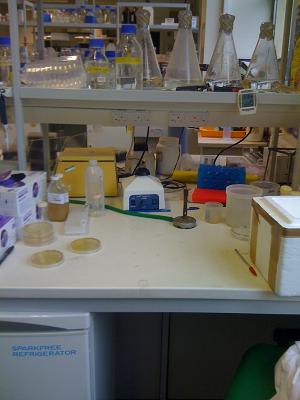Team:BCCS-Bristol/Wetlab
From 2010.igem.org
m (→Safety Issues) |
(→Safety Issues- From 2009, consider deleting) |
||
| Line 44: | Line 44: | ||
| - | ==Safety Issues- From 2009, consider deleting== | + | <!--==Safety Issues- From 2009, consider deleting== |
As the idea of communication between a certain population (in this case E.coli) could raise issues in health and safety of the general public the following precautions were taken during the implementation of the project in the laboratory: | As the idea of communication between a certain population (in this case E.coli) could raise issues in health and safety of the general public the following precautions were taken during the implementation of the project in the laboratory: | ||
| Line 57: | Line 57: | ||
*No purified DNA or biological material was left unattended at any time, and all DNA and biological material was suitably stored according to Level 1 Laboratory rules. | *No purified DNA or biological material was left unattended at any time, and all DNA and biological material was suitably stored according to Level 1 Laboratory rules. | ||
*Biosafety guidelines where followed under the BCCS-Bristol iGEM'09 supervising team and such guidelines fall within the description of a project that holds approval by the iGEM supervisor Dr.Nigel Savery. | *Biosafety guidelines where followed under the BCCS-Bristol iGEM'09 supervising team and such guidelines fall within the description of a project that holds approval by the iGEM supervisor Dr.Nigel Savery. | ||
| + | --> | ||
Revision as of 16:12, 26 October 2010
iGEM 2010
Subpage Structure
Team:BCCS-Bristol/Wetlab/Part_Design
Team:BCCS-Bristol/Wetlab/Beads
Team:BCCS-Bristol/Wetlab/Improvements
Team:BCCS-Bristol/Wetlab/Experiments
Team:BCCS-Bristol/Wetlab/Safety
Team:BCCS-Bristol/Wetlab/Project_Results
Team:BCCS-Bristol/Wetlab/Image_Gallery
Links to old pages
Team:BCCS-Bristol/Wetlab/Notebook
Team:BCCS-Bristol/Wetlab/BioBricks
Team:BCCS-Bristol/Wetlab/Lab_photos
Wet lab
The wet lab team have been focussing on further characterising the PyeaR promoter submitted by Edinburgh last year and on creating our own new Biobricks to engineer E. coli to produce GFP in response to nitrates.
We have also been examining different methods of encapsulating our bacteria to create pellets that could be easily spread by farmers on fields, as well as looking at signal detection and E. coli survival on soil.
For a more in depth view of what we have done so far, click on the Notebook section.
For a complete list of the biobricks used during our project, plus a brief description on their use, click here.
 "
"
